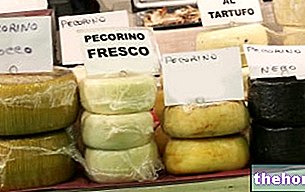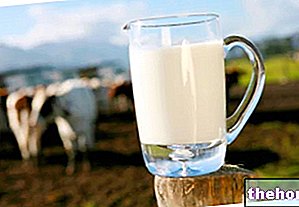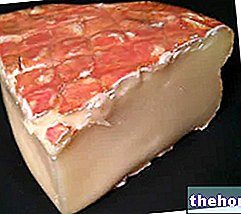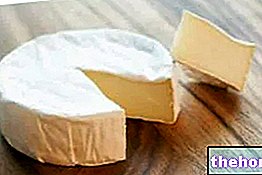Generality
Squacquerone is an Italian cheese, typical of the Emilia Romagna region. Its production is concentrated in the Romagna area (Rimini, Forlì-Cesena and Ravenna), but is also significant in the eastern Emilia area (eastern province of Bologna).

NB: squacquerone which does not have the “di Romagna” specification can be produced in any other area of Italy.
Squacquerone is produced with pasteurized whole cow's milk and belongs to the set of raw cheeses. Similar to crescenza, it has a white mother-of-pearl color, with a softer and creamier consistency, which often does not hold its shape (it melts) .
The cheese does not show any crust or surface film. Its bouquet is sober, delicate, simple; on the palate it is almost as sweet as fresh milk, but it is also characterized by some evident acidic notes (thanks to the lactic bacterial fermentation).
Originally, squacquerone was a typical cheese of the cold season. It was born at a family level, due to the urge to use milk produced in insufficient quantities to justify sending it to dairies. Considered a specific food of the pastoral community, the first traces of its diffusion in the higher social groups date back to the nineteenth century (bishop of Cesena).
Squacquerone is a fresh cheese. Requires storage without light, at low temperatures (refrigerator) and possibly in a sealed container. The shelf life of fresh food is limited to a few days. The packaged one has a rather short expiration date and once opened it must be treated as the previous one.
According to the classification established by INRAN and SINU, squacquerone falls into the II fundamental group of foods. Containing lactose it can be defined as a dairy product. From a nutritional point of view, it is above all a good source of: essential amino acids, calcium and vitamin B2 (riboflavin).
Nutritional Characteristics
From a microbiological point of view, squacquerone is a food considered safe.
During the production cycle, it has a fairly limited risk of pathogenic bacterial contamination; moreover, being made from pasteurized milk, it is suitable for the diet of the pregnant woman.
Squacquerone has a fairly high energy intake even if, compared to aged cheeses, it is decidedly less caloric.
Energy is mainly provided by lipids, followed by proteins and finally carbohydrates.
NB: Although some values in the table are missing, various nutritional characteristics are easily deducible.
Fatty acids are mainly saturated, peptides of high biological value (essential fatty acids in a quantity and ratio similar to human proteins) and simple carbohydrates (lactose).
Squacquerone contains a fair amount of cholesterol; fibers are absent.
The most important vitamins are B2 or riboflavin and the equivalent retinol or vitamin A. Small amounts of vitamin E (tocopherols) are highlighted. With regard to mineral salts, the concentrations of calcium, phosphorus and sodium stand out.
Squacquerone is one of the most suitable cheeses in the dietary therapy of subjects with metabolic diseases and high cardiovascular risk; hypercholesterolemics and hypertensive people are particularly involved. Nevertheless, it is necessary that the consumption is sporadic and the entity of the portions quite small.
The good concentrations of calcium and phosphorus make it suitable for the diet of the growing subject and at high risk of osteoporosis.
Squacquerone is allowed by the vegetarian philosophy but not by the vegan one.
It is not suitable for the diet against lactose intolerance, but it has no contraindications in case of celiac disease.
The average portion is around 80g (200kcal).
Gastronomic Aspects
Squacquerone is a dairy product with a delicate flavor and aroma; it is crustless, soft and easily spreadable.
The gastronomic use of squacquerone is as a cold dish (main course), in which it is accompanied above all with raw and fresh vegetables (lettuce, rocket, radicchio, tomatoes, cucumbers, fennel, carrots, celery, etc.).
It is often used as an ingredient in sandwiches, wraps and tigelle.
Other possible methods of consumption are: melted on pasta (without heating it in a pan) and spread on still hot grilled vegetables.
From an oenological point of view, it goes well with white or rosé wines with a light body, undemanding and possibly indigenous to the specific dairy production area (for example Pignoletto for the squacquerone of Castel Maggiore - Bologna).
Milk, Dairy Products and Cheeses Asiago Brie Burrata Caciocavallo Rennet Camembert Cheddar Milk Cream Crescenza Emmental Feta Milk Flakes Fontina Herbal Cheeses Lean Cheeses Cheeses rich in calcium Gorgonzola Gouda Grana Padano Gruyere Kéfalair Adapted milk Artificial milk Condensed milk Asphyxiated milk Goat's milk Sheep's milk Rice milk Soy milk Powdered milk and concentrated milk Skimmed and semi-skimmed milk Lactose-free milk Milk Vegetable milk Dairy products Lerdammer Mascarpone Montasio Buffalo mozzarella Mozzarella Whipped cream Cooking cream Fresh cream Parmigiano Reggiano Pecorino Philadelphia Primo Sale Provolone Ricotta Robiola Roquefort Scamorza Sottilette Squacquerone Taleggio Tomino Yogurt OTHER ARTICLES MILK AND DERIVATIVES Categories Alcoholic foods Meat Cereals and derivatives Sweeteners Sweets Offal Fruit Dried fruit Milk and derivatives Legumes Oils and fats Fish and fishery products Cold cuts S pezie Vegetables Health recipes Appetizers Bread, Pizza and Brioche First courses Second courses Vegetables and Salads Sweets and Desserts Ice creams and sorbets Syrups, liqueurs and grappa Basic preparations ---- In the kitchen with leftovers Carnival recipes Christmas recipes Light diet recipes Women's Day, Mum, Dad Recipes Functional Recipes International Recipes Easter Recipes Recipes for Celiacs Recipes for Diabetics Recipes for Holidays Recipes for Valentine's Day Recipes for Vegetarians Protein Recipes Regional Recipes Vegan Recipes




























